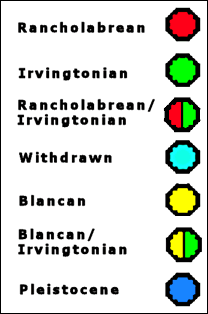Each Pleistocene fossil locality (site) has an account. Usually age, a general description of the site, and a list of the taxa identified from the site is given. Open sites that were treated by Morgan and Lucas (2003, 2005) have been given minimal treatment; the original publications give considerably more detail and there is little sense in my plagiarizing their work beyond the bare minimum. Each locality also has a literature section that includes authors who are cited in the text of the taxon account or faunal list, as well as sometimes those otherwise pertinent to the site.
 Each site is mapped if sufficient data to do so are available; placement of a site is only approximate. Blancan-age sites are shown with a yellow-centered dot; Irvingtonian-age sites with a green-centered dot; and Rancholabrean sites are noted with a red-centered dot. Originally, sites dated only as Pleistocene also received a red-centered dot; however, this is deemed to be misleading, and such red-centered dots are slowly being replaced with dark-blue-centered dots. Where both Irvingtonian and Rancholabrean or Blancan and Irvingtonian remains are present at a site (or the site age is indeterminate between two ages), the colored portion is divided between the two. Where a reasonable approximation of the locality of a site cannot be made due to the lack of data, a black dot is placed in the center of the dot's color field. Usually such dots will be placed near the center of the county involved (some taxa are cited only as Grand Canyon; in those cases, the dot will be placed toward the center of the canyon).
Each site is mapped if sufficient data to do so are available; placement of a site is only approximate. Blancan-age sites are shown with a yellow-centered dot; Irvingtonian-age sites with a green-centered dot; and Rancholabrean sites are noted with a red-centered dot. Originally, sites dated only as Pleistocene also received a red-centered dot; however, this is deemed to be misleading, and such red-centered dots are slowly being replaced with dark-blue-centered dots. Where both Irvingtonian and Rancholabrean or Blancan and Irvingtonian remains are present at a site (or the site age is indeterminate between two ages), the colored portion is divided between the two. Where a reasonable approximation of the locality of a site cannot be made due to the lack of data, a black dot is placed in the center of the dot's color field. Usually such dots will be placed near the center of the county involved (some taxa are cited only as Grand Canyon; in those cases, the dot will be placed toward the center of the canyon).
The "Sites" link on the Main Menu will take you to a page where there are links to the individual states that, in turn, have links to all the sites within the state.
Assignment here of a site to a specific time interval is fraught with danger. I have tried to follow the literature as best as I can, but some judgements are questionable and, in some cases, the possible time interval overlaps two NALMAs, with no certainty as to where the fauna actually occurred within the interval.
If, within the list of taxa, the nomenclature of a taxon has changed since publication, the currently accepted name is listed. Except for some of the earlier completed sites, the original name published by the cited author(s) is given beneath the line in indented and smaller type. Taxa represented in the UTEP Paleobiology Collection that have either not appeared in the literature, have had changes from a published account, or have appeared only in lists without being attributed, are indicated by the UTEP acronym.
Generally (but with exceptions), only taxa below the family level have been listed.
Literature.
Last Update: 6 Feb 2016